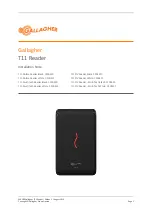
2) Note that maximum receiver sensitivity depends on data rate being in use at a particular
moment
3) Note that the PEAP uses MS-CHAP-V2 as an inner authentication method (IETF RFC2759)
4) Note that the CCMP is an AES-based block cipher protocol specified by the IEEE 802.11i, and
in the context of Windows Embedded CE, AES is used as a synonym for CCMP.
5.2 Wireless LAN Connectivity
On the Nordic ID Morphic, a ‘Wireless Zero Configuration’ (WZC) – a built-in automatic
configuration subsystem – is in charge of communication over WLAN. It provides different user
interface aspects of WLAN configuration and of networking information, a supplicant to support
802.1X protocols, and methods for wireless networking management. When the Nordic ID Morphic
is powered up, the WZC attempts to find out any networks within range, and it may automatically
connect to network(s) for which it has configuration. (In the WZC, the configurations for 802.11
networks are called preferred networks.) In case that you have not configured preferred
network(s), it pops up its dialog box called ‘Network Status Monitor’. The same may happen if there
is not the configured network in range, but it may take for a while after the system came on.
The WZC subsystem has two appearances being accessible on the desktop window. In addition to
its pop-up ‘Network Status Monitor’ dialog box with its icon on the taskbar, there is the wireless
interface icon in the window of the ‘Network and Dial-up Connections’ control panel applet.
5.2.1 Introduction to Configuring Wireless LAN Interface
The ‘Network Status Monitor’ taskbar icon has two forms. The point of the two icons is to
communicate the wireless LAN networking status on the taskbar. Both the icons do inform that the
WZC is up and running but the difference is whether or not the TCP/IP stack is ready to
communicate as follows:
TCP/IP stack has no IP-address for networking
TCP/IP stack has an IP-address for networking. However, this does not necessarily
mean that the assigned IP-address is valid in the networking context, because in
case that the DHCP address assigning fails the WZC may assign an IPv4 address
with the 169.254/16 prefix being valid for link-local communication only (for further
information see IETF RFC3927). The link-local IP-address is used for the
communication across ad-hoc links.
By double-tapping on either icon on the taskbar you can get the ‘Network Status Monitor’ dialog
box open. The dialog box gives an adapter view of the wireless LAN communication. Accordingly,
the title text of the dialog box is rather cryptic and it refers to the name used internally by Windows
Embedded CE for the instance of the wireless LAN adapter driver. The ‘Network Status Monitor’
presents four tabs: IP Information, IPv6 Information, Wireless Information, and Hardware.
IP Information tabs
The IP and the IPv6 Information tabs give current status of the IP address information assigned to
the wireless LAN interface. The tabs have the same function as the Network Status Monitor
taskbar icons, but the information is available in dotted-decimal notation format. If you assign a
static IP address to the interface the IP address will be shown on the tab as your Nordic ID Morphic
Nordic ID International Headquarters
Myllyojankatu 2A
FI-24100 SALO
FINLAND
Phone:
+358 2 727 7700
Fax:
+358 2 727 7720
Email: [email protected]
www.nordicid.com
















































